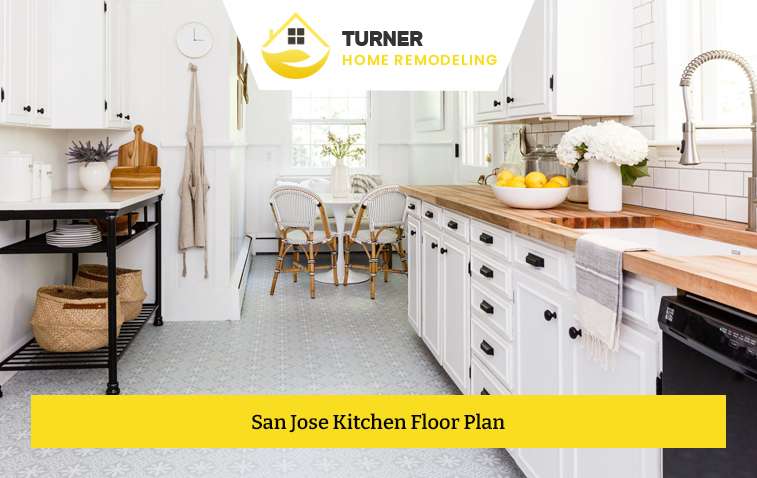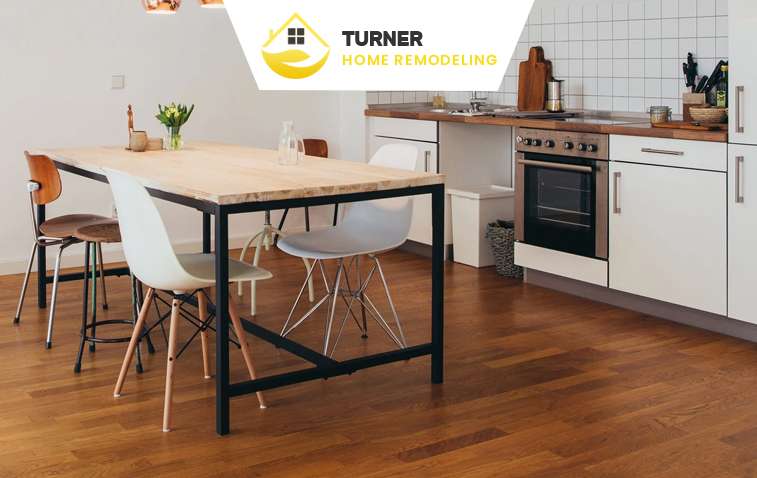- Call Us Now: (408) 809-0211
One of the most important aspects of any kitchen remodel is choosing the proper layout. This decision can significantly impact the functionality and overall feel of your space, especially in smaller kitchens common in San Jose homes.
Consider your lifestyle and cooking habits when choosing a floor plan. An open layout is great for entertaining, while a simpler one suits casual cooks. Budget wisely and prioritize essential elements to add long-term value. Create an efficient work triangle to ensure smooth traffic flow and consider ergonomics for maximum convenience and safety.
That’s why we’ve put together a comprehensive guide that will help you explore dynamic floor plan ideas for your San Jose kitchen. Get ready to be inspired as we dive into the world of kitchen layouts and how they can transform your cooking and dining experience. Let’s get started!

A kitchen floor plan is a detailed diagram that outlines the layout and design of a kitchen space. It considers the placement of appliances, countertops, cabinets, doors, windows, and other essential kitchen elements.
The floor plan visualizes the workflow and traffic patterns in the kitchen, helping homeowners and designers make informed choices about how to best utilize the available space for maximum functionality and aesthetics. Different types of kitchen floor plans include the popular U-shape, L-shape, and galley layouts, each offering its unique benefits and considerations.
When planning your San Jose kitchen floor plan, it’s essential to consider your lifestyle and how you intend to use the space. For avid cooks, a layout that provides ample workspace and easy appliance access could be a priority. For those who see the kitchen as a social hub for family gatherings or entertaining, an open-concept plan that facilitates interaction may be a better fit.
It’s also important to consider the number of people who regularly use the kitchen. If you have a large family or share your home with roommates, a layout allowing multiple cooks can help avoid congestion.
Smaller kitchens may suit a compact, efficient layout like a single-wall or galley design. Larger spaces, on the other hand, open up possibilities for island layouts or an L-shaped kitchen, which can offer a more open feel and additional workspace. Similarly, if your kitchen is narrow and long, a galley layout might work best, while a square kitchen could accommodate a U-shaped or L-shaped design more comfortably.
Measure your space to ensure your desired layout fits and flows well within the physical constraints. In the process of kitchen remodeling, be sure to consider any potential changes to the size and shape of your kitchen, as removing or adding walls could significantly alter your San Jose kitchen floor plan options.
When designing your ideal kitchen layout, remember to consider your budget. The cost of remodeling will vary based on the complexity of the changes. Moving plumbing or gas lines is pricier than replacing cabinets or countertops. Prioritize what matters most in your new kitchen and allocate your budget accordingly.
If you need help balancing your wish list and budget, consider professional guidance. Turner Home Remodeling specializes in creating beautiful, functional kitchens that fit your budget. We’ll work with you to design a floor plan that meets your needs and respects your financial constraints for a successful San Jose kitchen remodeling project.
The size and shape of your kitchen play a crucial role in determining the ideal floor plan. Smaller kitchens can benefit from efficient single-wall or galley designs, while larger kitchens offer the flexibility for island or L-shaped layouts. In narrow spaces, the galley layout works best, while square kitchens can comfortably accommodate U-shaped or L-shaped designs. Remember to take accurate measurements to ensure your desired layout fits the existing constraints.
If you frequently cook or entertain, you might appreciate a layout that provides ample workspace and easy access to appliances and storage. For those who view the kitchen as a social hub, an open floor plan for easy interaction may be the ideal choice. On the other hand, if you’re more of a casual cook, a more straightforward layout with less emphasis on the workspace might be sufficient. Ultimately, the floor plan should cater to your lifestyle, ensuring a comfortable and functional kitchen space.
The cost of remodeling your kitchen depends on the complexity of the changes you want to make. Prioritize the critical elements, allocate your budget, and consider the long-term benefits. A well-planned kitchen layout can enhance your home’s value.
The optimal positioning of the three main work zones: the refrigerator, the stove, and the sink. These points form an imaginary triangle that aims to improve efficiency by minimizing foot traffic between these areas. The ideal size of each leg of the triangle should fall between 4 and 9 feet to ensure that the kitchen space is neither too cramped nor too spread out.
Controlled traffic helps to maintain an efficient, safe, and clutter-free cooking environment. Your San Jose kitchen floor plan should facilitate easy movement between critical areas and appliances without obstacles.
It should also accommodate multiple users, if needed, without causing collisions or interruptions. For families with children, a well-considered traffic pattern can keep children away from danger zones like the stove while still allowing them to interact within the space.
This involves arranging and choosing design elements and appliances in such a way that they provide maximum convenience, safety, and ease of use. For instance, cabinets and countertops should be at the right height, minimizing strain during tasks such as cooking or cleaning. Similarly, having easy access to frequently used items can boost efficiency and minimize unnecessary movements. Consider the sequence of jobs in your regular cooking process and plan your kitchen layout accordingly.
At Turner Home Remodeling, we understand that a kitchen is more than just a place for cooking—it’s where daily life unfolds. If you’re planning a kitchen remodel in San Jose, contact us. We’ll listen to your needs, guide you through the design decisions, and work with you to transform your kitchen into a space you love.

Establishing a work triangle optimizes efficiency in your kitchen by positioning the three primary work areas: the refrigerator, the stove, and the sink in a triangular layout. The principle behind the work triangle is to minimize movement and create smooth traffic flow during cooking. Each leg of the triangle should ideally be between 4 and 9 feet to ensure the kitchen is neither too cramped nor too spread out.
A well-designed kitchen floor plan should include sufficient storage space to keep your countertops clutter-free. Consider incorporating cabinets, drawers, and shelves strategically to make the most of your available space. Maximize vertical storage with tall cabinets or utilize underutilized areas such as corners for added storage.
Think about the placement of appliances in your kitchen and how they will fit into your desired floor plan. Consider their function and frequency of use when deciding on their location. For example, stoves and ovens should be close to each other for convenience, while refrigerators and dishwashers should be placed away from the cooking area to avoid collisions.
A functional kitchen should have enough space for easy movement between critical areas and appliances without obstacles. Consider the number of users in your household and plan for multiple individuals to navigate the kitchen comfortably. This is especially important for families with children who must be kept away from dangerous zones like stoves.
A well-designed kitchen combines functionality, efficiency, and aesthetic appeal. Consider your lifestyle, cooking habits, and space constraints to select the ideal floor plan that meets your needs. A work triangle and ample storage space are crucial for functionality. Placement of appliances and traffic flow enhance usability and safety. With thoughtful planning, a kitchen remodel can transform your cooking zone into a vibrant hub, increasing enjoyment and adding value to your property. A well-planned kitchen layout enhances your cooking and dining experience.